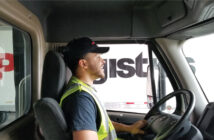by
WHEN IT COMES to running a trucking company amid economic unease, supply chain issues, high inflation and a worker shortage, there’s no substitute for experience. Dutch Guest, Tony Knowles and Steadman Taylor have yet to turn 40, but they’ve spent decades in the industry and are using their accumulated knowledge to weather challenging times and position their businesses for the future.
As they monitor long-term trends like the emergence of alternative-fueled trucks and automation, these young executives remain focused on the pressing issues of today, recognizing that those challenges may linger a while.
Those concerns include the aging of the trucking industry’s workforce, the persistent driver shortage, high turnover rates, rising costs for insurance, frivolous lawsuits and high prices for labor, fuel and equipment.
The majority of drivers in the industry are between the ages of 50 and 65, according to the American Transportation Research Institute (ATRI), so Dutch Guest, 38, is infusing his business with some youthful enthusiasm.

Two years ago, Guest partnered with the University of Georgia’s Terry College of Business to establish an internship and part-time hiring program at Watkinsville-based LAD Truck Lines. So far, about a dozen students have worked at the company, learning about the industry and gaining valuable experience. Guest said their presence has benefited his company as well.
“Drivers like talking with the younger folks, and it just really improves morale,” he said. “The biggest thing is just how eager these young people are to learn and how quick they are in learning technology. These kids whip out formulas in Excel and put all these analytics together, so they’ve been a great addition to our team.”
Guest, a GMTA board member, became president of LAD Truck Lines last July, with his father, Mack Guest III, serving as chief executive. The refrigerated carrier specializes in poultry, meats and other foods and provides third-party logistics for clients out of three dry warehouses. It has about 100 tractors, 150 trailers and 30 employees.
During their six-week summer internship, students learn about customer service, safety, regulations, dispatching, setting up appointments for delivery and pickup, taking inventory in a warehouse and loading and unloading trucks. Interns get paid an hourly wage and can earn college credits, and several have joined the company full time upon graduating.
“Any time we can educate young people about our industry, that’s a win,” Guest said.
STAFFING UP
This fall, LAD Truck Lines had three students working part time, helping the company bolster its customer service and lighten the workload for day-shift employees. In the past, some employees who worked daytime hours would be on call at night, fielding phone calls from customers wondering about the status of their loads and drivers encountering a problem.
That practice led to some long nights and took a toll on day-shift workers, Guest said. In response, the company established a small call center staffed 24/7, including a supervisor working remotely. The added manpower allows customers to get a faster response to their inquiries and gives employees a better work/life balance. This approach takes on added importance given the time-sensitive nature of food products such as turkeys, Guest said.
“With our young people who have come in, that’s helped us shift to this model,” Guest said. “When a customer calls and wants to know where their load is, you’d better be able to give them an answer. They need resolution now. This business doesn’t stop. It’s all day and night, including weekends and holidays.”
IMPROVING RETENTION RATES
Last fall, the American Trucking Associations estimated the national driver shortage at 80,000, a figure expected to rise to 160,000 by the end of the decade given current industry trends. The dearth of young drivers entering the field is the main reason industry stakeholders successfully pushed for the DRIVE Safe Act to be included in last year’s bipartisan federal infrastructure bill.
Currently, truck drivers must be 21 or older to cross state lines, but the legislation establishes an apprenticeship program for drivers ages 18 to 20, allowing them to enter the industry sooner. That should help trucking companies address a key obstacle in recruiting young people, who typically begin making career plans before turning 21.

Still, the driver shortage underscores the importance of outreach efforts to young jobseekers, including educational presentations at high schools, according to Steadman Taylor, vice president of Moultrie-based Broadleaf Trucking Co. Similarly, the industry must step up its recruitment of women, who accounted for only 7 percent of drivers in 2021, according to the ATA.
In promoting the industry to young people, companies should emphasize the opportunity to earn a high salary while seeing the country, Taylor said.
“The trucking companies that are going to continue to be successful will figure out ways to make driving more attractive to young people,” he said. “Driving a truck is similar to being your own boss. The truck is your office, and you’re working independently.”
Taylor, 39, runs Broadleaf Trucking with his brother, Phillip. The company has about 65 employees, 50 tractors, 175 dry vans, 20 refrigerated trailers and three flatbeds, and it specializes in moving agricultural products, poultry and manufactured goods.
“The workforce shortage certainly is the No. 1 concern,” Steadman Taylor said. “The driver shortage is the biggest struggle, but there’s also a shortage of maintenance technicians and mechanics because those are demanding jobs, too.”
Taylor said Broadleaf Trucking has increased wages for drivers and other positions and has begun awarding them up to two weeks of paid vacation after sticking with the company for two years. In addition, the company has dispatchers call drivers on the phone each week to check in on them and to talk about something other than trucking.
Dispatchers ask drivers if there’s anything in their professional or personal lives that they need help with, and they keep logs of those calls so supervisors can review them. That practice allows the company to take action before an issue escalates and sends an unhappy worker heading for the exits, Taylor said.
“We’ve been doing that for about 18 months, and it’s really helped with our retention,” he said. “It’s critical to maintain a steady focus on your employees.”
As many states relax their marijuana laws, the pool of available drivers is impacted. From January 2020 to this past April, 98 percent of testing infractions among drivers stemmed from drug use, not alcohol, according to the Federal Motor Carrier Safety Administration.
Last May, 92,779 CDL or commercial learner’s permit holders were in “prohibited status,” according to the agency, meaning they’re temporarily prohibited from driving a commercial vehicle due to a positive test for alcohol or drugs.
At the start of the pandemic, news outlets highlighted the essential role trucking companies play in our economy and broader society, and supply chain shocks put a premium on trucking capacity. Nevertheless, trucking companies are now seeing line-haul rates decrease and profit margins tighten due to rising costs for fuel, equipment, insurance and wages, Taylor said.
“The margins are thin, and that’s forcing us to run our equipment longer than we’re used to,” he said. “We’re running a leaner operation and pushing our resources toward driver wages, making sure we take care of our key employees.”
TECHNOLOGICAL TRENDS
Looking ahead, trucking executives expect technological advances to affect the industry in positive ways, but in terms of organizational planning, those aren’t major factors yet.
Better asset-tracking technology, automated warehouse equipment and the digitization of forms and processes are improving operations. Battery-powered electric trucks and alternative-fueled vehicles gradually will gain market share, and driverless technology will continue to advance.
At present, however, executives remain concerned about the lack of available charging infrastructure for electric trucks, which makes them unsuitable for long-haul companies. With parking spaces for trucks already in short supply, finding spaces equipped with charging stations adds another wrinkle of complexity for drivers.
Additionally, companies operating on narrow profit margins may find it difficult to pay the high upfront costs associated with electric trucks, especially smaller carriers, said Guest. “I don’t think diesel is going away anytime soon,” he said.

Tony Knowles
Recent pilot programs suggest that self-driving trucks could be seen on America’s highways in increasing numbers over the next three to five years, according to Tony Knowles, operations manager for his family’s business, Super K Express. The Newnan-based company has more than 50 drivers moving dry van freight such as industrial plastics and retail goods.
“It’s going to increase utilization of equipment, and that’s where the return on investment is going to come from,” said Knowles, a GMTA board member. “A lot of that technology is pretty close to being rolled out, so I feel like we’re not too far off from seeing that.”
However, liability concerns and the complexity of last-mile delivery likely will make it difficult to remove drivers from the equation, at least for the foreseeable future, said Taylor.
INSURANCE RATES SPIKING
In the short term, rapidly rising insurance rates stemming from frivolous lawsuits are the “biggest thing hurting profitability,” Knowles said, adding that personal injury attorneys have “put a target on [the industry’s]back.” Indeed, billboards advertising the large judgements won by accident lawyers on behalf of clients line the nation’s major highways.
From 2010 to 2018, the average size of large-judgement cases involving trucking companies jumped from $2 million to $22 million, according to ATRI. Consequently, the average trucking company’s insurance costs per mile increased 47 percent from 2010 to 2020, with small fleets paying more than three times as much as the largest fleets on a per-mile basis, ATRI reported.
“Looking at the industry over a 20-year perspective, that might be the biggest battle we face,” Knowles said. “But despite all the challenges facing the industry, I’m still optimistic about the outlook. We’re still experiencing great demand from our customers, and we’re still looking forward to growing and expanding our fleet for the remainder of this year and 2023 as well.”



